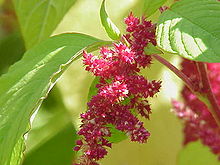
Back قطيفة (نبات) Arabic قطيفه ARZ Amaranthus AST Pəncər Azerbaijani قاراتره AZB Амарант Bashkir Bayem BAN Аксамітнік Byelorussian Щир Bulgarian Bayam BJN
| Amaranth | |
|---|---|

| |
| Amaranthus tricolor | |
| Scientific classification | |
| Kingdom: | Plantae |
| Clade: | Tracheophytes |
| Clade: | Angiosperms |
| Clade: | Eudicots |
| Order: | Caryophyllales |
| Family: | Amaranthaceae |
| Subfamily: | Amaranthoideae |
| Genus: | Amaranthus L. |
| Species | |
|
See text | |
Amaranthus is a cosmopolitan group of more than 50 species which make up the genus of annual or short-lived perennial plants collectively known as amaranths. Some of the more well known names include "prostrate pigweed" and "love lies bleeding".[1][2] Some amaranth species are cultivated as leaf vegetables, pseudocereals, and ornamental plants.[3] Catkin-like cymes of densely packed flowers grow in summer or fall.[4] Amaranth varies in flower, leaf, and stem color with a range of striking pigments from the spectrum of maroon to crimson and can grow longitudinally from 1 to 2.5 metres (3 to 8 feet) tall with a cylindrical, succulent, fibrous stem that is hollow with grooves and bracteoles when mature.[5] There are approximately 75 species in the genus, 10 of which are dioecious and native to North America with the remaining 65 monoecious species endemic to every continent (except Antarctica) from tropical lowlands to the Himalayas.[6] Members of this genus share many characteristics and uses with members of the closely related genus Celosia. Amaranth grain is collected from the genus. The leaves of some species are also eaten.[7]
- ^ St. Clair, Kassia (24 October 2017). The Secret Lives of Color. Penguin Group. p. 130. ISBN 978-0143131144.
- ^ "Amaranthaceae | plant family". Encyclopædia Britannica. Retrieved 2015-06-02.
- ^ Bensch; et al. (2003). "Interference of redroot pigweed (Amaranthus retroflexus), Palmer amaranth (A. palmeri), and common waterhemp (A. rudis) in soybean". Weed Science. 51: 37–43. doi:10.1614/0043-1745(2003)051[0037:IORPAR]2.0.CO;2. S2CID 86018188.
- ^ RHS A–Z encyclopedia of garden plants. Dorling Kindersley. 2008. p. 1136. ISBN 978-1405332965.
- ^ Cite error: The named reference
schmidwas invoked but never defined (see the help page). - ^ Steckel, Lawrence E. (April 2007). "The Dioecious Amaranthus spp.: Here to Stay". Weed Technology. 21 (2): 567–570. doi:10.1614/WT-06-045.1. S2CID 84733087.
- ^ Wong, James (9 February 2020). "Amaranth tastes as good as it looks". The Guardian.
© MMXXIII Rich X Search. We shall prevail. All rights reserved. Rich X Search